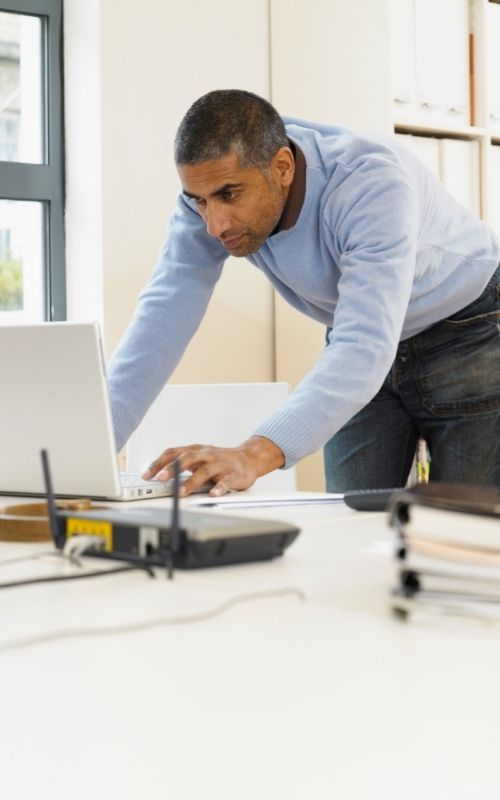There are many elements involved in building the perfect workspace. You need the right chair, a few cute pictures to keep you motivated, and a laptop to complete your tasks on.
Using a standing desk adds another element to the workspace. Now you need to decide what height to put the standing desk at. Do you raise it up to your hips? What position will keep you comfortable and focused the entire day?
Here’s everything you need to know about standing desks and how to get the most out of this ergonomic office staple.
Table of Contents
How to Determine the Ideal Standing Desk Height?
There isn’t one set standing desk height. If 100 people all tried out the same desk, it would probably need to be adjusted 100 times.

An individual’s height will determine their standing desk height. Both adjustable and non-adjustable standing desks are on the market, but we always recommend going with an adjustable desk so you can customize your experience.
Some people think that an individual’s body height is important in determining their standing desk height. That’s not always the case. Everybody’s proportions are different, so one person may have very long legs and a short torso, or vice versa and this will change how tall they need their desk to be.
The general rule is that a standing desk should be the same height as your elbows. That way, you can type without straining your arms and shoulders. If you choose to take a more relaxed position during the day, they can comfortably rest on the desk while you’re working.
To figure out how tall your elbows are, reach your arms forward and bend them 90 degrees like you’re typing away on your computer. The height of your elbows in that position is how tall your standing desk should be.
You don’t need to follow this rule exactly, but it’s a good starting point. If you decide using it higher or lower feels more comfortable, have at it!
What if the Desk is the Wrong Height?
Having a standing desk at an incorrect height can cause long-term and short-term problems. Here are a few potential problems you could come across if you don’t customize your standing desk correctly.
Too Tall
Having your standing desk sit too tall is a common problem. It’s supposed to be taller than a traditional desk, but it doesn’t need to tower over the office.

If your desk is set well above your elbows, you will find your shoulders and arms becoming sore and stiff. Reaching your hands up to type or do desk work is fine for a minute or two, but it can cause wrist pain and general discomfort over long periods.
A tall desk might also mean you have to arm your back to reach everything. This may not feel very awkward at first, but the whole point of ergonomics is finding sustainable positions. Arching your back is not sustainable, so you shouldn’t avoid it.
You will also be craning your neck, and since our heads are surprisingly heavy, this would quickly become uncomfortable.
Too Short
A short standing desk is arguably worse for you than a tall standing desk. Your lower back would pay the price first, which is ironic considering people usually buy standing desks to help with their back pain.

Hunching over is never great. It warps your spine and puts a lot of pressure on your lower back. When you subtly bend your spine forward, you risk not noticing the damage it’s inflicting until it’s too late.
You also might end up bending your knees too much, which could lead to soreness and stiffness.
Finally, not having a clear view of your computer screen may strain your eyesight. Strained eyesight may lead to headaches and lower rates of productivity.
Whenever you’re at your standing desk, ask yourself if your posture is correct, if your spine is aligned, and if your legs are standing tall while still relaxed.
Standing Desk Height Calculator

Not everyone has the luxury of being able to use an electronic or adjustable standing desk–but that’s okay!
If you’re shopping around online and need help determining what height to get your standing desk at, we’re here to help!
| Height (in inches) | Standing Desk Height | Seated Desk Height |
| 5’0” | 39” | 23” |
| 5’1” | 39” | 23” |
| 5’2” | 40” | 24” |
| 5’3” | 40” | 24” |
| 5’4” | 41” | 25” |
| 5’5” | 42” | 25” |
| 5’6” | 43” | 26” |
| 5’7” | 43” | 26” |
| 5’8” | 44” | 26” |
| 5’9” | 45” | 27” |
| 5’10” | 45” | 27” |
| 5’11” | 46” | 28” |
| 6’0” | 47” | 28” |
| 6’1” | 47” | 29” |
| 6’2” | 48” | 29” |
Once again, these are just estimates. Your proportions will determine the exact standing desk height for you. We incorporated the seated desk height just in case you get an adjustable standing desk and need to know where to bring it back down once you’re done standing.
You could even put little markers on the desk legs so you don’t have to worry about measuring the height every time you want to stand up. Ideally, you should be alternating between standing and sitting throughout the day. You want to make that transition as seamless as possible.
Tips to Use a Standing Desk Correctly

Now that you know the height your standing desk should be at, let’s go over how to use a standing desk correctly to get the most out of it.
To start, you need to be mindful of how long you use the desk every day. It’s tempting to jump right in and try to stand all day long, but that won’t get you very far.
Ease into your standing desk and try to stand for no more than an hour in total the first day. You can work your way up quickly, but you first need to gauge how your body feels on its feet for long periods first.
You should consider the type of shoes you’re wearing. Thin soled shoes can cause foot problems, especially if you’re standing on hard flooring. We suggest opting for padded or supportive footwear that will protect your feet.

In terms of your posture, keeping your spine aligned and comfortable is essential. Think about how ergonomic office chairs are designed to provide enough lumbar support and straighten your spine–you should aim to recreate that while standing at your desk.
Your feet should be hip-width apart. You want to feel grounded and secure. Some individuals struggle with their balance, so feeling stable is particularly important.
You know what height your desk should be at, but what height should your computer rest at? The computer screen should be where your eyesight naturally falls. You may need to raise your screen to make this possible; adding a few thick books and a small box is a convenient, budget-friendly way to do this.
Struggling with back or leg pain? Sometimes taking a foot off the ground gives your spine the rest it needs to get through the day. Using a firm box, prop one foot up for around 10-15 minutes before putting it down and bringing the other foot up. Alternate regularly.
What to do if Your Desk Isn’t Moving

What if you go to adjust your desk and it doesn’t move? There are a few ways to troubleshoot this issue.
First, see if anything is blocking the desk. You may have accidentally placed something underneath it that’s stopping it.
You should also check to see if your legs are even. The desk needs to be completely flush with the floor to work properly.
Still not working? Try resetting your desk!
To do this, first, remove everything from the desk. Then, unplug the desk for at least 30 seconds. You must wait the full 30 seconds, otherwise, it will not reset. Plug the desk back in and lower it completely.
This should reset the system and make maneuvering it smoother.
If all else fails, you may need to consider getting a new motor for your desk. This can be a little overwhelming, so consider if it’s worth replacing the motor instead of just buying a new desk.
In Conclusion
The most important thing to remember is that a standing desk should be as tall as your elbows. Your height is an important factor, but your elbows ultimately decide the height.
The repercussions of not setting up your desk properly could be quite painful, so listen to your body and tweak the desk height accordingly. You want standing to feel natural and painless.
There are two types of standing; active and passive. Try to stand actively as much as possible. Engage your core, be awake of where your feet are, and keep your head held high. This will help you maintain correct posture for longer.
If you find your desk isn’t moving like it should, run through the troubleshooting solutions. Have a look at your desk’s manual for specific resetting instructions.
How tall do you like to keep your standing desk? Do you think the elbow height rule works well for you? We’d love to know in the comments below!
Good luck!

My name is Vance, and I am the owner of To Ergonomics. Our mission is to improve your workflow by helping you create a supportive and welcoming environment. We hope that you’ll find what you’re looking for while you’re here.

